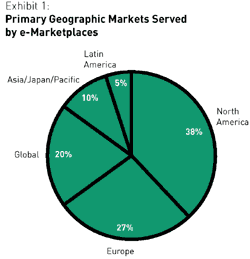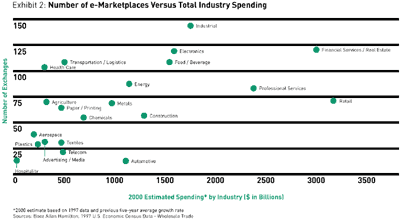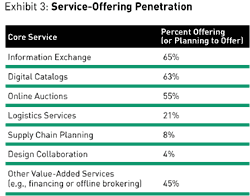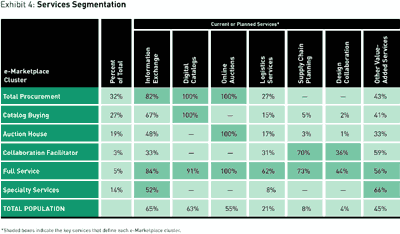B2B Benchmark: The State of Electronic Exchanges
Business-to-business e-commerce is fraught with peril for buyers and sellers alike. An exclusive survey of 1,800 e-Marketplaces shows what it takes to win.
 |
|
David Plunkert |
Over the last two years, journalists, scholars, and self-proclaimed experts have written volumes about business-to-business e-commerce. Thousands of newspaper articles, dozens of popular business books, and countless online newsletters examine the phenomenon from every angle — save one. None of these sources has conducted a truly rigorous examination of the new business model that we call e-Marketplaces.
We define an e-Marketplace as a forum that leverages the Internet to facilitate commerce among businesses. Such a definition obviously encompasses a wide range of entities — from independent or pure-play dot-coms financed by venture capital, to industry consortia backed by pooled funds, to private networks created by individual companies.
Such e-Marketplaces burgeoned during the last five years. As was inevitable, a shakeout has begun; most of these marketplaces will fail. The fate of individual firms, however, will depend on the strategic decisions they make over the next 12 months. Many characters will play roles in this B2B drama — the founders, operators, and investors who shape strategy and tactics, as well as the buyers and sellers whose choices will ultimately determine the survivors. Given the vast number of entities and the breadth of participants, most corporate leaders will play some part in the evolution.
This year, Booz Allen Hamilton teams in the U.S., Latin America, Europe, and Asia/Japan/Pacific identified 2,233 publicized e-Marketplaces and profiled 1,802 of them in detail. (See “Profiling the Players”.) Our examination, the most comprehensive yet undertaken on this subject, offers insight into the drivers of success and provides a baseline for monitoring the inevitable fallout over the coming year.
|
Profiling the Players |
|
Teams in four regions — the U.S., Europe, Latin America, and Asia/Japan/Pacific — culled public data sources and identified 2,233 announced e-Marketplaces; the teams were able to find information at the described URL for 1,802 of them. This discrepancy reflects announced plans that never got off the ground, as well as exchanges that may have launched but quickly failed. Even within our population of 1,802 profiled entities, some have since joined the dot-com graveyard. By examining the e-Marketplaces’ published materials and their Web sites, and in some cases interviewing members of management, the four teams documented geographic scope, industry focus, ownership structure, technology providers, and, most importantly, service offerings. We then employed a mathematical technique known as cluster analysis to classify the profiled e-Marketplaces into logical groupings. The techniques examined the mix of services offered to cull the 1,802 entities into a mere six clusters — out of a possible 128 permutations. Those six clusters offer a new segmentation that highlights the evolving nature of the e-Marketplace landscape. |
Our research documented three ownership models and six basic service offerings across 24 traditional industry segments. By examining the key data on service offerings in combination with the market size, we have concluded that independent or “pure play” e-Marketplaces, currently representing an overwhelming proportion of the population, risk extinction. Founded in the heady days of Internet mania, most face huge ongoing technology investments, competition-driven price erosion, and limited liquidity resulting from their failure to create a clear value proposition that appeals to either buyers or sellers.
The e-Marketplaces formed by consortia, a small proportion of the total today, appear to have the strongest base, but they risk being hobbled by conflicting agendas among their founding companies. If they can survive the machinations of their founders and truly integrate the services required in a particular industry, consortium-based e-Marketplaces are most likely to blossom into defensible full-service operators. Indeed, they could fundamentally transform the structures of select industries.
Finally, private networks sprouting from the in-house systems of many major companies represent the newest phenomenon — and a threat to both independents and consortium-based e-Marketplaces. Operated for the exclusive use of the single owner, private networks will not drive a fundamental restructuring of an industry, but may consume resources that could otherwise support the independents and consortium-based models.
We have also concluded that the new breed of slower-growing collaborative e-Marketplaces may prove more resilient than the rapidly propagating varieties of procurement-driven e-Marketplaces.
An Evolving Ownership Model
There are three basic ownership models for e-Marketplaces: independents, consortia, and private networks.
The overwhelming majority of e-Marketplaces — 92 percent of our total — were developed by independent entities or pure-play operators, generally with the hope of cashing in on the enormous dot-com valuations seen from 1996 through 2000. AutoTradeCenter.com Inc., founded in 1997 and ranked by Forbes as among the “Best of the Web” in July 2000, offers an excellent example. It provides an online forum where automobile dealers, banks, rental agencies, and fleet companies can obtain information on, buy, and sell preowned vehicles.
AutoTradeCenter is a publicly traded company, which makes it an exception among independent e-Marketplaces: Only 6 percent of these pure-play entities have gone public. The vast majority remain private, dependent on venture-capital funding to finance their losses as they build their infrastructure and seek members. With so many competitors, and with venture funding increasingly scarce, most privately held independents will quickly disappear. For the 6 percent whose shares are traded, the tombstones of Webvan Group Inc., eToys Inc., and dozens of other one-time high-flying B2C Internet companies are reminders that access to public financial markets is no guarantee of survival.
The consortium model, in which various industry players — including competitors — combine forces to create a common forum for the exchange of goods and services, has received broad press coverage. Yet these e-Marketplaces, which include Aeroxchange in aerospace, Covisint LLC in automotive, Trade-Ranger in energy, and Transora in consumer goods, account for fewer than 5 percent of the total — a mere 92 e-Marketplaces around the globe. This small group receives a wealth of attention because of its typically large and deep-pocketed founders and the often unique conditions that allowed competitors to band together to develop (and control) their own e-Marketplaces.
Take Transora, formed by a consortium of leading consumer-products companies — including Coca-Cola Company, Proctor & Gamble Company, and Unilever PLC — and the Grocery Manufacturers of America to facilitate e-commerce among suppliers, manufacturers, and retail trade partners. The idea for it originated at a March 2000 meeting of e-business leaders from the industry. In less than six weeks, 49 consumer-products companies, including 24 of the 25 largest in the world, had signed letters of intent for the creation of Transora, which eventually resulted in $238 million in funding.
Private networks represent an even smaller proportion of e-Marketplaces today: There were only 57 (3 percent of the total) in our worldwide survey. Private networks, like the Dell Computer Corporation’s e-Marketplace, facilitate e-commerce transactions up and down the supply chain — in this particular instance, between Dell, its corporate customers, and its suppliers. The most common function of private networks is online cataloging to facilitate sales from the sponsoring company, but some networks also support such supplier-focused services as supply chain planning and design collaboration. Private networks often evolved from in-house systems, and some have struggled to find the optimal value-added role in the vast landscape of e-Marketplaces.
Wal-Mart Stores Inc. is a leading example of the evolved private network. Wal-Mart chose not to invest in the two major consortia backed by other players in the retail industry, WorldWide Retail Exchange LLC and GlobalNetXchange LLC. Instead Wal-Mart decided to move its existing supply chain infrastructure, SupplierLink, to the Internet. SupplierLink, built over the last decade for an estimated investment of $1 billion, had given Wal-Mart unparalleled control over its vast network of stores and suppliers. The retail giant’s new private network enables its 10,000 suppliers to cull information about sales and inventory levels in every store. With the expanded Internet functionality, Wal-Mart plans to consolidate purchasing worldwide, create global collaboration, establish real-time information flows, bring suppliers online to compete for contracts, and negotiate better deals. Though clearly focused on the direct benefits to Wal-Mart, the private network also should benefit suppliers by providing consolidated forecast data and allowing them to bid online for new lines of merchandise.
North American Domination Our research underscores that e-Marketplaces are, to date, primarily a North American phenomenon. Thirty-eight percent — 684 of the global total — claim North America as their principal market served. Although Europe has a comparably sized economy, only 485
Our research underscores that e-Marketplaces are, to date, primarily a North American phenomenon. Thirty-eight percent — 684 of the global total — claim North America as their principal market served. Although Europe has a comparably sized economy, only 485
e-Marketplaces focus primarily on the European market. The rest of the world combined accounts for even fewer than Europe: A mere 173 such marketplaces are directed to the Asia/Japan/Pacific region, and only 88 serve the Latin American market. Finally, another 372 claim to serve the global market rather than any one region — but, in truth, most actually concentrate their resources on North America and Europe. (See Exhibit 1.)
With the Internet boom well past and most global consortia already formed, we expect few new e-Marketplaces other than private networks. North America will certainly maintain its lead over other regions. But the region will also lead in failures over the coming months and years.
Industry Mix
Our profiling efforts show that some industries have far too many e-Marketplaces. For example, 106 center on the transportation-and-logistics industry. With such a large number of exchanges in a relatively small industry, most of these competitors will disappear. In larger industries with relatively few exchanges, such as the automotive industry (17 e-Marketplaces), the competitive pressures will be less intense. Although effective execution of differentiating strategies ultimately drives success or failure, e-Marketplaces in industries with relatively few exchanges have the best chance for survival. (See Exhibit 2.)

The highest failure rate, however, likely will be among the 170 generalist e-Marketplaces, which lack the base provided by a well-defined vertical market. These generalists focus on a specific, narrow functionality like auctions and forego a particular industry focus. Take, for example, Asset Assist Ltd., an Australia-based e-Marketplace created to buy, sell, and trade such assets as machinery, plant-and-equipment supplies, and furniture. When last we checked, it had no items listed in its 25 asset categories. With so many competitors in the field, the services offered by these exchanges are quickly becoming commodities, making it difficult for these less-focused companies to build defensible positions. An industry-focused player that tailors generic software to the nuances of a specific industry will have better odds of generating enough value to cover its cost.
Service-Offering Penetration Profiles In examining the service offerings of the e-Marketplaces, we discovered six core services — information exchange, digital catalogs, online auctions, logistics services, supply chain planning, and design collaboration — plus numerous niche and specialty services. One might expect the penetration rate for a core service (that is, the percentage of exchanges offering it) to be high, as individual e-Marketplaces adopt a mix of services in order to attract the greatest membership. Yet penetration rates vary widely, from a high of 65 percent to a low of 4 percent. (See Exhibit 3.)
In examining the service offerings of the e-Marketplaces, we discovered six core services — information exchange, digital catalogs, online auctions, logistics services, supply chain planning, and design collaboration — plus numerous niche and specialty services. One might expect the penetration rate for a core service (that is, the percentage of exchanges offering it) to be high, as individual e-Marketplaces adopt a mix of services in order to attract the greatest membership. Yet penetration rates vary widely, from a high of 65 percent to a low of 4 percent. (See Exhibit 3.)
Nearly two-thirds of the e-Marketplaces offer information exchange services. Such a high penetration comes as no surprise: Information exchange costs relatively little and helps to build a sense of community among the membership.
Digital catalogs have the second-highest level of penetration (63 percent). Though far more costly than simple information exchange services, digital catalogs offer a much clearer value proposition to customers and suppliers. Suppliers can gain access to a broader customer base without the incremental production and distribution costs of paper catalogs. Suppliers and customers alike save in transaction costs. Two widely known e-commerce software providers, Ariba Inc. and Commerce One Inc., aggressively sell the benefits of digital catalogs; both hope to achieve the network effects of a dominant market share. In pursuit of high growth and the greatest number of installations, each has partnered often with both independents and consortia to create many of the e-Marketplaces.
Online auctions, offered by 55 percent of the profiled e-Marketplaces, represent the third most popular service offering. With consistent reports of double-digit savings for buyers, online auctions provide an easily measurable value proposition in e-Marketplaces. Even when priced with a small transaction fee, these e-Marketplaces can profit considerably, since online auction software can be acquired for as little as $50,000. Unfortunately, suppliers don’t share the positive view: Most have experienced significant margin squeeze when forced to compete through this e-Marketplace service.
Beyond online auctions, the penetration rates for service offerings drop dramatically. Logistics — facilitating the physical flow of goods within a firm or between a firm and its suppliers and customers — ranks fourth (21 percent). Managing the wide variety of transportation modes and linking the fragmented carrier market offer a rich value proposition to many customers. At the same time, smoothing the physical movement of goods rather than just the data flow offers a far more difficult challenge than the top three services, a difficulty that helps explain the relative paucity of players.
Supply chain planning tools, like those offered by Manugistics Group Inc. and i2 Technologies Inc., help companies share sales and production forecasts over the Internet. Such collaboration reduces uncertainty in planning, which in turn decreases the need for inventory safety stock. According to our research, only 8 percent of the e-Marketplaces offer supply chain planning services.
Design collaboration (4 percent penetration) ranks the lowest among our six core services. Of greatest interest to e-Marketplaces serving original equipment manufacturers (OEMs), design collaboration allows these manufacturers to work with their first-tier suppliers to share the workload in product development.
Though the specifics vary dramatically, 45 percent of the e-Marketplaces offer some other form of service, typically either finance-related or something unique to an industry, such as the chemical regulatory compliance and tracking tools offered to farmers by the e-Marketplace XSAg.com. These value-added services appear to be an area where players can differentiate themselves.
Segmentation by Service Offering
Rather than simply examine the penetration rate of individual service offerings, we also decided to look at the service mix proffered by the exchanges. The segmentation provides a richer portrait of the evolution of the e-Marketplace phenomenon and hints at which type of firms are most likely to survive the current e-business shakeout. (See Exhibit 4.)

• Total Procurement. The largest cluster — covering 32 percent of the e-Marketplaces in our survey — encompasses companies that concentrate on digital catalogs and online auctions, the two core Internet procurement services. The majority of this segment (82 percent) also offer information exchange services. Among this segment, 9 percent have gone public.
PartMiner Inc., founded in 1993 to serve the global electronic-components industry, is representative of the Total Procurement segment. This e-Marketplace provides Internet-based applications to facilitate the product selection and purchasing processes. Like most early startups, PartMiner began with a revenue model that combined subscription fees and a transaction charge. The model soon proved unsustainable for the company, as it has for many other e-Marketplaces in this segment. In June 2000, PartMiner canceled all of its 2,200 subscriptions and relaunched. It now provides free access with no transaction fees, but charges a small fee for the services of a team of professional buyers who search for rare and hard-to-find components. With this free-access model, PartMiner hopes to draw users to the site and profit from the revenue generated from the 2 percent of its users who need assistance obtaining hard-to-find products.
• Catalog Buying. A quarter of the companies in the sample classify as Catalog Buying operations. Two-thirds of this segment provide information exchange services in addition to digital catalogs. Private networks represent a disproportionate percentage of this segment: Although private networks constitute only 3 percent of the e-Marketplaces currently in operation, they account for 6 percent of the Catalog Buying segment.
Dell’s e-Marketplace, a celebrated example of a typical buyer-sponsored private network, offers a lesson for all e-Marketplaces: Do not be afraid to change. In fact, Dell has transitioned its e-Marketplace strategy multiple times. Although it started by offering corporate customers a customized “electronic storefront” to accept orders over the Internet in September 2000, by November 2000, Dell had extended that functionality to allow corporate customers access to its full supplier community. Just four months later, Dell shut down the expanded service offering, citing changing market dynamics, lack of maturity in the e-commerce market, limited customer readiness, and competition from established players. Now that it has returned to its core e-Marketplace, Dell offers an archetypal example of a catalog-only operation — selling goods to its corporate customers.
• Auction Houses. E-Marketplaces focused primarily on online matching of buyers and sellers constitute one-fifth of the profiled population. These companies focus on auctions and do not offer digital catalogs, though a small percentage offer other services. Because online auction functionality, pioneered by FreeMarkets Inc., dates to the earliest days of B2B e-commerce, several Auction House e-Marketplaces have six years or more of experience — an eon in Internet time.
Like Dell, some Auction Houses have adapted their business model many times during their relatively long life spans in response to changing market dynamics. Altra Energy Technologies Inc., for instance, was founded in 1996 as the first electronic marketplace for energy. Although the Altra Market Place for real-time trading serves as the core of the company’s business, it now also offers Altra Market Solutions to help energy companies create customized portal applications, as well as Altra Market Tools to assist in front-, mid-, and back-office transaction management. The expansion into software means that Altra works with more than 7,000 energy professionals across 500 companies worldwide to trade and schedule transactions in electronic power, energy commodities, natural gas, and crude oil. The result? With software revenues up 15 percent in 2000, Altra is now less dependent on transaction fees from auctions.
Altra’s decision to concentrate on a single industry and its willingness to expand services offer two survival lessons for members of this segment. With the cost of auction software dropping, no company will survive by offering generic auction services. An Auction House will need to become an expert “market maker” in certain industries to survive. Furthermore, Auction Houses should expand into other service offerings, such as logistics and supply chain planning, because the narrowly focused Auction House segment will surely be the hardest hit in the coming consolidation.
• Collaboration Facilitators. Although Collaboration Facilitators occupy a much smaller slice of the surveyed population (3 percent), they represent an emerging trend. Most early e-Marketplaces focused on online auctions, and many of them found that service too one-sided to attract a sustainable community of buyers and sellers. Accordingly, they added other services likely to attract suppliers. The Collaboration Facilitators segment goes a step further, abandoning the tensions inherent in the procurement and price-negotiation processes and focusing exclusively on aiding collaboration between buyers and sellers. Both supply chain planning and collaborative design tools encourage cooperation between buyers and sellers. As a result, they attract participation from both sides of the commercial transaction. Concentrating on win–win options, these e-Marketplaces do not even offer auction services.
Two-year-old Buzzsaw.com serves architecture, construction, and property-management companies as a strategic resource. Buzzsaw’s online collaboration and printing applications connect project teams to save time and increase profitability through better information sharing. Subscribers pay a monthly usage-based fee to produce, transmit, and store digital blueprints; to exchange plans, forms, change orders, loans, and other documents; and to bid out specific work to qualified subcontractors. As a result, this e-Marketplace acts as a virtual conference room and storehouse for property owners, general contractors, subcontractors, architects, and engineers to meet and view one another’s work without ever leaving their desks.
• Full Service. Full Service exchanges represent only 5 percent of the e-Marketplace population, and for good reason. A company needs deep pockets to simultaneously develop information exchange, digital catalogs, online auctions, logistics services, supply chain planning, and design collaboration. Although all the core services achieve a high penetration in this segment, only six entities — less than one-half of 1 percent of our survey population — currently offer all six services. Naturally, the Full Service cluster has the highest percentage of consortium sponsorship. Although consortia represent less than 5 percent of the total e-Marketplace population, they account for 19 percent of this segment.
Covisint, the automotive-industry consortium, is one e-Marketplace that offers all six services. Created in February 2000 by a merger of AutoXchange and TradeXchange (independent exchanges under development at Ford Motor Company and the General Motors Corporation, respectively), Covisint now also lists DaimlerChrysler AG, Renault SA, and Nissan Motor Company among its members. By combining $240 billion in purchasing scale, Covisint plans to speed product development, enhance competition among the supply base, and streamline the flow of parts through the supply chain to save more than $1,000 per vehicle.
Like most e-Marketplaces, Covisint has assembled technology from a number of companies: Commerce One powers its catalog and auctions, SupplySolution Inc. supports supply chain planning, MatrixOne Inc. and Engineering Animation Inc. (recently acquired by Unigraphics Solutions Inc.) combine to satisfy design collaboration, and Oracle provides the underlying technology platform/infrastructure. Members can access these tools through the Covisint portal, which will eventually provide links so that data can be seamlessly transferred from one application to the next. With different applications working in an integrated manner, it will be possible for items won in an online auction to be transferred seamlessly to a digital catalog, along with the winning price, and later tied to the supply chain planning tool to schedule orders.
• Specialty Services. The entities in the Specialty Services segment offer only two core services (information exchange and logistics services). In fact, some players in this segment may not qualify as e-Marketplaces by others’ definitions. But because they leverage the Internet to facilitate commerce among businesses, these Specialty Services providers meet our definition. By and large, companies in this cluster provide information or other niche services of value to a single industry. The narrower scope of this segment provides a smaller potential revenue base; 6 percent of its constituents — more than double the percentage of the rest of our profiled population — have already failed.
UpstreamInfo.com shows how a Specialty Services e-Marketplace can survive. An information and business solution provider for the upstream petroleum business, UpstreamInfo was formed in May 2000 by Chevron, EDS, The Information Store, and Raytheon. The company’s service links upstream petroleum companies, government agencies, and service contractors by targeting the duplication and waste in the petroleum industry’s expenditure on engineering and geoscience information. With $50 billion spent annually on information to find, extract, and process oil, the industry could save tens of millions of dollars each year thanks to UpstreamInfo’s specialty service.
Predictions and Advice:
Likely Winners and How to Avoid Losing
Constant change seems to be the only certainty in business today — and the e-Marketplace phenomenon offers an example accelerated beyond even the normal hectic pace of our times. Out of the 1,802 e-Marketplaces we profiled in detail, dozens failed even as we compiled our survey. As in all periods of upheaval, failure will predominate, although some exchanges will succeed wildly. The three groups that have the most at stake in the coming shakeout — consortium participants, independent e-Marketplaces, and mid-sized corporate buyers and sellers — have different expectations of survival.
• Consortium Participants. Immediate transaction volume from committed founders (on top of the massive funding typically provided by these behemoth companies) gives the consortium e-Marketplaces an initial advantage. But two factors will ultimately drive their success or failure. First, a successful consortium will need to create an integrated suite of services that becomes the industry standard. Simply serving as an application service provider selling software “by the drink” adds too little value to justify the cost.
Second, a small set of founders must remain committed to the survival of the consortium and ensure the financing and usage fees that keep the e-Marketplace afloat while it builds the desired capabilities. A small number of founders — such as the five large automotive OEMs backing Covisint — offers the greatest likelihood of committed support. On the other hand, Transora (the packaged-goods e-Marketplace), with 49 founders, risks dilution. With so many players, no one participant feels the necessary ownership or commitment to ensure Transora’s survival.
Alternatively, there’s a breakaway strategy — one that redefines the industry. Imagine a consolidation among the multiple exchanges in the retail industry (like Transora and GlobalNetXchange) in conjunction with a third-party logistics provider (like Excel) to tackle services beyond the software tools described previously. Such a combined entity could offer to take control of the full distribution network and logistics between consumer-products manufacturers and major retailers (the founders of Transora and GlobalNetXchange, respectively) and create a new entity — one offering digital and physical outsourcing of the goods along the chain. The combined entity could eliminate hundreds of separate distribution centers currently operated independently by the manufacturers and retailers. Such a move would be riskier than the shared resource model, but could offer rich rewards by freeing billions of dollars in assets for the retailers and manufacturers.
• Independent e-Marketplaces. With venture capitalists now more cautious and the IPO market effectively closed, independent e-Marketplaces must become intently focused on the bottom line to conserve cash. Launching new services in a field-of-dreams model is no longer affordable. In fact, even sustaining some services may destroy value. Auction services continue to offer the most immediate returns to customers, and accordingly the best chance for extracting value in the short term. Unfortunately, online auction systems and support face rapid commoditization, making them increasingly tenuous revenue streams over the long run unless an e-Marketplace has built industry expertise that is deep enough to differentiate it from the competition.
We do not believe that independent e-Marketplaces can succeed in the Full Service model. Though some consortia, like Covisint, may eventually create seamless links among the services and thereby dominate an industry, such aspirations would be impossible for an independent. Even the Total Procurement players may discover that they have bitten off more than they can chew, largely because the transactional focus of digital catalogs requires a great deal of investment but delivers relatively low benefits.
Among independents, niche players should have the best chance of survival — if they have built a sustainable customer base delivering a clearly visible value proposition. If an independent lacks a strong membership and offers a vague overall value proposition, we recommend seeking a deep-pocketed consortium, ideally one in need of fresh resources looking to embark on a breakaway strategy.
• Mid-sized Corporate Buyers and Sellers. Most mid-sized companies sat on the sidelines as the initial e-Marketplace game unfolded. Although initially chided for inertia, their conservatism has paid off. The time is now ripe to exploit the e-Marketplace investments financed by the venture capitalists, software vendors, and corporate behemoths. Even the successful e-Marketplaces need more buyers to take full advantage of the increasing returns and scale advantages available in many e-business platforms.
A savvy mid-sized company should be able to extract favorable terms from competitors seeking to expand. At the same time, committing to a particular e-Marketplace requires a fair amount of due diligence. Joining any e-Marketplace implies significant investment in changing internal practices to extract the real value. Reengineering a business to work with an e-Marketplace that goes under in six months will prove to be a worthless investment.
Similarly, many mid-sized companies have gotten the short stick as a seller in an e-Marketplace. Though most have suffered through margin pressures from online auctions and consortium buying programs — without the promised revenue increases from their customer base — the tide is turning. The large corporate buyers now recognize that online auctions will yield decreasing returns over time and may even become disadvantaged once weaker players exit and eliminate excess capacity. Accordingly, e-Marketplaces have shifted their focus from aggressive procurement tactics to the collaborative tools supporting supply chain management and joint product design. These provide opportunities for mutual gain through waste elimination rather than simple margin shifting. Sellers should embrace these opportunities to differentiate themselves with services and not just price.
The sellers of catalogable products should also see increasing opportunities. Many buyer-led efforts at building digital catalogs have been white elephants. Although touted for their transactional efficiency, most digital catalogs lack clean links to back-room payment processing systems; they may offer convenience to the corporate user, but not the desired transactional cost savings. Seller-sponsored digital catalogs available to any corporate consumer with a Web browser offer the same convenience, with no multimillion-dollar investment by the buying company. You can expect greater adoption of independent seller-driven solutions in the future, particularly by mid-sized companies that avoided the hype of e-procurement but now see the potential benefit.
Next Steps
In the end, companies large and small need to step back and rethink their e-business strategies and the role of e-Marketplaces.
The early participants made major investments in a market lottery that appeared to produce only winners. Now that the too-good-to-be-true returns of the dot-com era have proved to be just that, companies need to return to the more pedestrian task of implementing the powerful technology of the Internet.
Consortium founders must break their emotional attachment to past investment decisions and reconsider the role for the consortium versus independent e-Marketplaces versus a private network.
Armed with clear strategies, independents can pick their spots or exit gracefully, as appropriate. Mid-sized companies must accept that e-Marketplaces represent more than a passing fancy and develop clear strategies to win as both buyer and seller in this new world.
In all cases, the answer lies in the economics and industry dynamics as uncovered in a thoughtful and well-executed business strategy — not in the media or the market, both prone to overreact to the momentum of the times. ![]()
Also contributing to this article were Booz Allen Hamilton Principal Bob Lukefahr (lukefahr_bob@bah.com) and Senior Associate Jim Kaboski (kaboski_james@bah.com).
Reprint No. 01404
| Authors
Tim Laseter, lasetert@darden.virginia.edu, serves on the operations faculty at the Darden Graduate School of Business at the University of Virginia. Previously he was a a vice president with Booz Allen Hamilton in McLean, Va. Mr/ Laseter has 15 years of experience in building organizational capabilities in sourcing, supply chain management, and operations strategy in a variety of industries. Brian Long, long_brian@bah.com Brian Long is a principal with Booz Allen Hamilton in Chicago. He focuses on operations and sourcing strategy. Chris Capers, capers_christopher@bah.com Chris Capers is a senior associate with Booz Allen Hamilton in Chicago. He specializes in operations and e-business strategy. |





